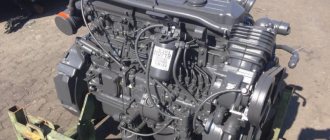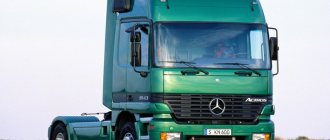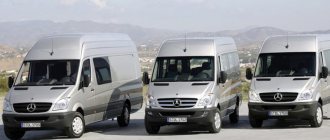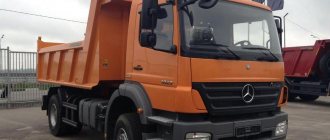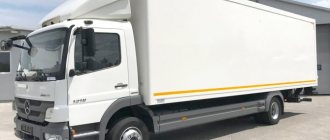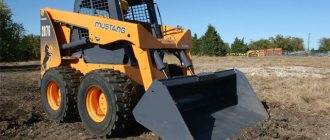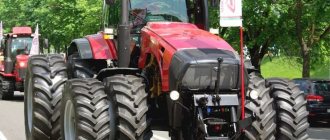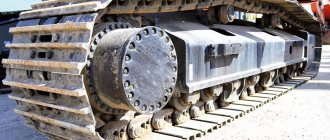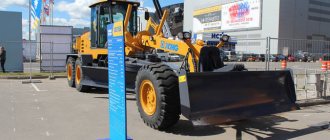The universal chassis of the Mercedes Unimog is designed for the installation of various utility superstructures and can be used in the armed forces. Several generations of equipment were produced, differing in the dimensions and outlines of the cabin and cargo platform. All all-terrain vehicles are equipped with single-ply tires with a developed tread and have an all-wheel drive system that allows you to move in severe off-road conditions.
Development and creation of a universal machine
After the end of World War II, a group of German engineers, with the support of the American administration, began developing a utilitarian agricultural machine that was in demand on the European market. The prototype of the car under the designation Unimog (short for Universalmotorgerät, “universal motor unit”) was ready in the fall of 1946, and 3 years later at the Boehringer plant, mass production of vehicles with rear-wheel drive only, equipped with diesel engines, began.
Since the enterprise did not provide the required productivity, the project was sold to Daimler-Benz, and in 1951, assembly line assembly of the 401 model began at the Mercedes Benz plant in Gaggenau. In 1955, the modernized generation of Unimog S 404, equipped with a 4x4 transmission, which was actively used in the German army, saw the light.
The cars were produced until 1980 and were equipped with in-line diesel engines OM615 or gasoline engines of the M130 and M180 series.
Since 1963, production of the agricultural 406 series began with increased power of power units (only diesel engines were offered) and a reinforced frame that made it possible to install various equipment. In the mid-70s. the cars were modernized and began to be offered in 2 modifications (435 and 425, which differed in the center distance). The design retains the power take-off shaft and a separate hydraulic circuit for the agricultural attachment.
In the 80s a new cabin with an asymmetrical hood appeared. At the same time, additional safety systems developed for Mercedes-Benz trucks were introduced into the design of the vehicle. At the same time, attempts are being made to create a version with interior elements from passenger cars. In 1994, the small-scale Funmog was released, and 10 years later the U500 Black Edition model appeared (already on a new platform introduced in 2000). The assembly of vehicles in Russia was carried out by the joint venture Daimler Kamaz Rus, located on the territory of the KamAZ plant.
About the history of the car and tales about it
One of the first Unimog models
Any media, and especially German sources, will tell you an interesting story about the creation of this SUV. So, Albert Friedrich, head of the Daimler-Benz aircraft engine design department, after the war, in the fall of 1945, in his office, he sketched out on paper the first drawings of the Unimog or UNIversal MOtor Gerät (“universal motorized vehicle”). According to the author's idea, it was supposed to be an all-wheel drive mixture of a truck and a tractor, with high traction power and cross-country ability in mud. The purpose is exclusively agricultural. And people believe this story...
Radspeller OST tractor from Skoda
If you delve deeper, the archives contain similar drawings of the Mannschaft Transport Gerät (Combat Crew Vehicle) vehicle, dated 1942, by the same creator - Albert Friedrich. The Germans were famous for their half-track artillery tractors, which were fast, high-torque and extremely capable, but very expensive to create. In the winter of 1942, the Germans lost many vehicles near Moscow; a cheap and widespread alternative was required. So Mr. Friedrich proposed his own option. Germany was a capitalist country and the MAN and Opel lobbies did not allow the project into their segment, so the enterprising Albert Friedrich hid it for better times. Its best times, not Germany.
Mercedes Unimog for the army
Albert Friedrich and a group of engineers left Mercedes shortly after the fall of 1945 and developed a purely agricultural vehicle for 4 years. Then Daimler-Benz bought the project again, and a few years later they began to sell cars en masse, first to the new German army, and then to armies around the world. This is the real story.
What industry is it used in?
Main areas of car use:
- In municipal services for cleaning roads or transporting waste in off-road conditions (for example, when cleaning a forested area). There are firefighting modifications for extinguishing fires in hard-to-reach areas, equipped with a pump and containers for water and a special composition for producing foam. A set of hoses and auxiliary equipment are transported on board the vehicle, allowing the roofing of buildings to be dismantled.
- On railways as a shunting vehicle capable of towing a train weighing up to 1000 tons on a horizontal section of track. The vehicle, converted to rail travel, is used to deliver repair crews and equipment to the restoration work area. Instead of a loading platform, a crane beam can be mounted and used when installing concrete sleepers or rails.
- In emergency services responsible for repairing electrical networks or gas pipelines. Special equipment is installed in a closed body, and rest areas are provided for crew members.
- For transportation of unit personnel and various weapons. This is what the Unimog military vehicle is designed for.
- For active recreation. The modifications are equipped with a residential module (mobile home). There is a heating system inside, and there are places for relaxation and cooking. The design of the walls of a motorhome depends on the model: there are modules with lightweight partitions, and products with insulated partitions (for use in the Far North).
Unimog U403
0
Since 1973, Mercedes Benz has been introducing another new product to the market called MB Traс - a tractor assembled on the Unimog platform. Despite the great popularity and active sales of trucks, in the agricultural world the result was slightly lower than what the manufacturer expected. MB Trac was supposed to fix the situation in the tractor segment. All-wheel drive like the Unimog, the MB Trac had four wheels of the same size, but a more recognizable tractor design - an angular, high cab located between the axles. The use of disc brakes and high technology Unimog made this model revolutionary at the time. During production until 1991, the tractor improved its modifications and was used not only in agriculture, but also in forestry.
Model range in the table
Unimog models are usually divided into several series:
- early generations 401/402 and improved 411, produced until 1975;
- the first version with all-wheel drive 404, which lasted on the assembly line until 1980;
- the 406 family (including models 416, 426, 419, 403, 413, 421 and 431), which were assembled until the early 90s;
- light series LBU (407 and 408);
- medium MBU series (417 and 418);
- heavy series SBU (424, 425, 435 and subsequent - 427, 436 and 437);
- series for extreme road conditions 437.4, produced in the 2000s.
First generation
The first generation is usually understood as the LBU, MBU and SBU series, assembled in the 90s. last century.
The characteristics of the machines are given in the table.
| Parameter | 408 | 418 | 427 |
| Length, m | up to 5.07 | up to 5.623 | up to 6.1 |
| Width, m | 1,912 | 2,096 | 2,3 |
| Height, m | up to 2.59 | up to 2.67 | 2,875 |
| Base, m | 2.69 or 3.22 | 2.83 or 3.9 | from 3.25 to 3.85 |
| Turning radius, m | 11.2 or 13.3 | 12.0 or 13.85 | — |
Second generation
The characteristics of the machines are given in the table.
| Parameter | U216 | U323 | U427 | U530 long |
| Wheelbase, mm | 2800 | 3000 | 3150 | 3900 |
| Permissible total weight, t | 10,0 | 13,8 | 14.0 | 16,5 |
| Turning diameter, m | 12,6 | 13,7 | 14.3 | 16,9 |
| Length, m | 4,9 | 5,1 | 5,15 | 6,2 |
| Width, m | 2,15 | 2,2 | 2,2 | 2,3 |
| Height, m | 2,82 | 2,9 | 2,9 | 2,97 |
| Maximum speed, km/h | 89 | 89 | 89 | 89 |
In addition, special regional Unimog models are produced.
For example, the U20 modification differs in the use of a shortened wheelbase and a diesel engine from the Accelo truck, produced in Brazil.
The equipment is supplied to the markets of developing countries with left-hand traffic.
Unimog U406
0
A tilting cab, power steering, pneumatic brake booster, and the ability to use Unimogs as mini-locomotives thanks to the addition of a railway mode (additional wheels for the railway track are installed on the car) appear. The light series was continued by such models as the U54 (type 403) with a wheelbase of 2250 mm and the U40 (type 421) with a wheelbase of 2380 mm. The variety of attachments for the Unimog makes it an indispensable all-rounder for utilities. The number of modifications, both serially and to order, is constantly growing. Since 1970, Unimogs with an open cockpit have been equipped with safety frames.
Equipment characteristics
Main technical characteristics (using the example of the U423T railway modification):
- engine power - 231 hp. With.;
- environmental class - Euro 5 or 6;
- permissible total weight - up to 13 tons;
- length - 5.5 m;
- width - 2.3 m;
- height - 3.0 m;
- wheelbase - 3.0 m;
- highway speed - up to 90 km/h;
- speed on rails (with load) - up to 25 km/h;
- permissible trailer weight of the train is up to 1000 tons.
Railway modifications differ from standard ones by the installation of a special air compressor, which ensures the operation of the braking system of the cars. The design of the chassis includes runner wheels with an adjustable track, ensuring that the machine is kept on the rails. Automatic railway couplers are mounted on the frame, and there are outlets for connecting hoses of the pneumatic brake system. The equipment is painted bright yellow, and orange flashing lights and an audible signal are placed on the roof of the cab.
Exterior and interior of Mercedes
The Unimog has an angular design. Located above the front axle, the cabin has a larger windshield area, providing an improved view of the road from the driver's seat. Fuel tanks and a urea reservoir are located on the sidewalls of the side members, and protection against damage to the tanks is provided. The driver enters the cabin through a hinged door; there are steps on the front fender.
The equipment is equipped with standard rear-view cargo mirrors with an increased viewing area.
The cars use a cabin with an asymmetrical shortened hood and a flat floor, in which driver and passenger seats are installed, separated by a power unit casing. The driver's seat is adjustable in several directions, and the position of the steering column can be adjusted in 2 planes. Upon request, the seat is mounted on a pneumatic support, which reduces vibration levels. The steering wheel is equipped with additional buttons for controlling auxiliary systems. To increase the level of comfort, air conditioning and heating are provided.
Motors used
The Unimog vehicles produced in 2022 use 4- and 6-cylinder diesel engines of the OM 934 or OM 936 models with a variable charging system, developing power up to 299 hp. With. The motors are equipped with a forced liquid cooling system. To reduce exhaust toxicity, a urea injection unit is installed (a separate tank is provided for storing the AdBlue reagent supply).
Previous generations of Unimog used different versions of diesel engines.
For example, the U400 model was equipped with a 238-horsepower engine that complies with Euro-3 toxicity standards. There is a supercharger driven by the exhaust gas flow. The manufacturer claims the ability to start the engine at temperatures from -18°C without additional air heating. The U4000 model was equipped with a 177-horsepower OM904LA unit, and the U5023 was equipped with a 300-horsepower modification. With.
The units are equipped with a dry clutch with 1 disc; a pedal located at the driver’s seat is used for control. The transmission includes a gearbox with a built-in transfer gearbox that evenly distributes torque between the axles. To control the box, a lever located on the central tunnel in the cabin is used. The transmission allows the vehicle to accelerate to 90 km/h (civilian versions can reach speeds of up to 110 km/h). Railway modifications are equipped with a hydromechanical transmission.
Steering part
The steering is of a hydraulic type, the drives to the rotary hubs are routed inside the portal-type axles. On some vehicles, it was possible to reinstall the steering column on the sides of the cab (depending on the work being performed). The hydraulic system pump is driven by the power unit; the fluid pressure in the circuits reaches up to 170 bar.
Brake system
The braking system includes disc brakes with pneumatic drive. The source of compressed air is a compressor installed on the engine cylinder block. The system is divided into circuits, there is an anti-lock braking system ABS with an electronic force distribution function (taking into account the load). When operating in off-road conditions, the unit is switched off or switched to a special operating mode that provides improved cross-country ability.
Unimog U437
0
At the beginning of the new century, Unimog celebrates its 50th anniversary with new models in the range: U300, U400 and U500, medium-heavy trucks that have received the greatest recognition in the field of road and municipal services. And in 2002, the heavy Unimog series was replenished with chassis with increased cross-country characteristics - U3000, U4000, U5000, presented at the Hannover Truck Exhibition. Unimog production in Germany is moving to the city of Werte, but in 2011 it will go even further - to the KamAZ plant, where the first Unimog in Russia is rolling off the assembly line.
average cost
The price of used cars depends on the technical condition, level of equipment and year of manufacture. For example, copies produced in the 60s and 70s. will cost the buyer up to 750 thousand rubles, the U-416 modification, assembled in the early 80s, has a price tag of up to 1.2 million rubles. The price of new generation cars exceeds 10 million rubles. (determined based on negotiations with the dealer), used copies will cost less. For example, the cost of a 5-year-old U5000 Wagon flatbed truck is within 6 million rubles.
First.
0
There were a large number of orders for Mercedes Unimogs; the car was even ordered from Europe for military purposes. The manufacturer simply could not cope with such volumes. At this time, Daimler-Benz began to take a closer look at the production of cars. In 1951, the concern acquired the rights to manufacture the Unimog, and large-scale production began at the Gaggenau plant. In the same year, the manufacturer released the Unimog 2010 model. From a thousand units in 1951, production increased by the next year to almost four thousand cars. It is curious that although the Unimog was produced as a Mercedes brand car, it had its own logo on the hood: the letter “U” in the form of a bull’s head. Only in the mid-50s did the three-pointed Mercedes star appear on the radiator grille of new models.
Russian analogues
In the USSR, and then in Russia and the CIS countries, several models of cars were produced that were conceptually close to the Unimog:
- Army GAZ-66, equipped with a V-shaped gasoline engine and permanent drive on all axles. The driver can increase cross-country ability by bleeding air from the tires. The Russian analogue is equipped with a 4-speed gearbox and an additional 2-speed gearbox, its load capacity is 2 tons. The vehicle was assembled in small batches at the Ukrainian KrAZ plant (it has no external or design differences from its Russian analogues).
- Chassis Ural-43206, characterized by the use of a cab with a hood arrangement. This design provides an increased level of protection against landmines or mines (the vehicle was developed by order of the military). The truck is equipped with a ladder frame, the transmission includes a 5-speed manual transmission and a 2-speed transfer case. The car is designed for driving on paved roads and off-road. The vehicle is not suitable for towing wagons.
Fuso trucks based on Unimog
The Fuso brand trucks produced by Daimler Kamaz Rus have nothing to do with the Unimog platform and were created by the design bureau of the Mitsubishi concern. The basic chassis has a load capacity of 7.5 or 8.55 tons, and it is possible to install flatbeds or vans for transporting commercial cargo or food products. The assembly of the universal Unimog equipment has been discontinued due to the low popularity of the machine.
All-wheel drive truck Silant
The Silant machine was developed by NAMI designers based on a number of solutions borrowed from Unimog. Assembly is carried out in small batches (for example, from 2009 to 2015, only 500 copies were shipped). The equipment has an increased load capacity of up to 4.5 tons. The plant installs MMZ, Cummins or YaMZ diesel engines with a power of up to 155 hp. pp., working in conjunction with a SAAZ or ZF manual transmission. The cars produced differ in wheelbase. There are modifications of the car and tractor, differing in wheels and travel speed.
It's him. At the parade.
0
At the beginning of 1961, the fifty thousandth Unimog truck rolled off the assembly line. By this time, Unimogs gained fame as universal all-terrain vehicles. They are used not only as agricultural and military transport, but also as assistants in urban utilities. Gradually, engine power increases to 32 and 34 hp. In 1963, Unimog introduced the Unimog U406 series with a four-sided attachment feature. The first Unimogs of this series were produced with a powerful six-cylinder engine of 65 hp. — during production, the power increased to 110 hp. The wheelbase was 2380 mm. The second generation Unimogs became typical representatives of the brand: in 1966, Mercedes Unimogs reached the mark of 100 thousand units. The expansion of the model range begins: the plant assembles U34, U40, U70, U80, as well as Umimog S, intended for civilian use. Unimogs are becoming more powerful and larger.
Unimog U500 Black Edition from Brabus.
0
Even such a hard worker suits an expensive suit.
In the summer of 2011 in Russia, at the joint enterprise of the German concern Daimler AG and KamAZ OJSC, Mercedes-Benz Trucks Vostok (MBTV), the assembly of special vehicles - Unimog all-terrain trucks - began. The first model assembled at the plant in Naberezhnye Chelny was the Unimog U400 locomobile, intended for road and municipal services. The Unimog is assembled in Russia using the large-knot method (SKD), from kits from the Daimler AG plant located in the city of Werth.
